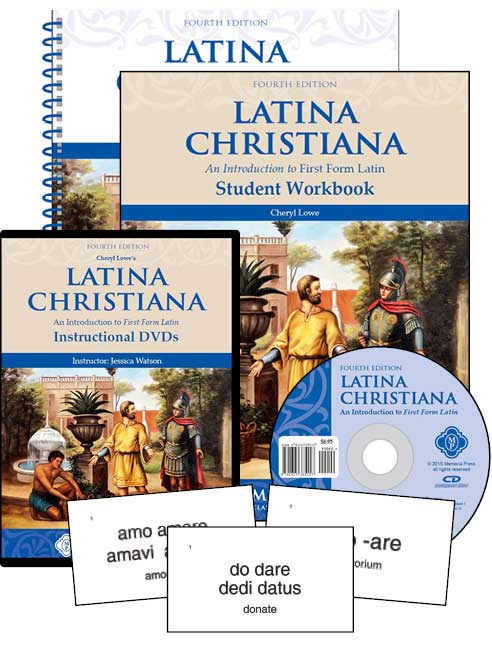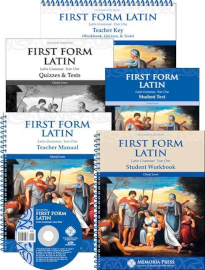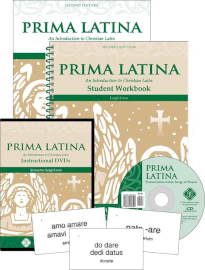Cheryl Lowe, founder of Memoria Press, believed that Latin is the ideal foundation for a classical education for children in the elementary grades. Ideally, Latin study replaces some English language study (particularly grammar and vocabulary) through these years. All of these courses teach grammar—both Latin and English. While conversational language is sometimes taught, these are not conversational programs that leave the grammar for high school. Memoria Press’s Latin programs should appeal most to classical educators who want to capitalize on the younger child’s ability to memorize and drill to build a strong grammar-level foundation.
Parents with no Latin background should find the Memoria Press courses very easy to use. Lesson preparation is minimal for the first two programs. These are not independent study workbooks. You really need to use the teacher manuals for lesson presentations.
Prima Latina offers a slower, gentler pace for learning Latin that might suit children in grades two through four. Latina Christiana might be the starting point for students in grades three to five while First Form Latin could be the first course for students in grades five and up. Parents unfamiliar with Latin themselves should probably choose the lower-level option when faced with two possibilities. Whichever courses you choose, by the end of eighth grade, students should be prepared for advanced Latin in high school, including reading Latin literature. They should also find the study of English and any of the Romance languages much easier.
All of these Memoria Press courses teach medieval or “church” Latin pronunciation rather than “classical.” You should find the companion CDs or streamed audio files very helpful for learning pronunciation. Words and phrases relating to Christianity are included; content should be appropriate for both Protestants and Catholics.
Memoria Press Latin courses were developed with small classes of homeschoolers, and that is the ideal setting for them. However, the courses also work fine with a single student and parent.
Optional streamed instructional videos do some of the teaching for you. Parents worried about their ability to teach Latin as well as those short on time should really appreciate this option. While not a critical factor, it is important to note that instructors on most video presentations speak with a southern accent. Hearing Latin spoken with a southern accent might be disconcerting to some listeners.
Prima Latina
by Leigh Lowe
Unlike most resources for Latin for the early elementary grades, Prima Latina is a strong, grammatically-based program. It teaches both English grammar and beginning Latin. Students are introduced to the seven parts of speech and three verb tenses of English grammar. For Latin, students are introduced to the first two declensions of nouns and the first two verb conjugations while learning some basic vocabulary. While Memoria Press says it can be used by children in grades one through four, they qualify this by saying that it is “for students who are still becoming familiar with English grammar but are competent readers.” I would add that students need to be fairly competent writers since there is quite a bit of writing in the course.
Children work directly in their worktext, but lessons need to be taught. Young children will need a great deal of teacher assistance.
Weekly lessons each begin with instruction on new material with examples. There is a vocabulary list with about five words per lesson. Children learn both the meaning and spelling of the vocabulary words through drills and exercises. Lessons also include lists of derivative words that help students begin to see how Latin roots are used to build English words. “Practical Latin” for each week introduces a word, phrase, or sentence such as “Vale” (“Goodbye,” said to one person), that students can use immediately and frequently. Latin prayers are introduced one line at a time. Students respond both orally and in writing through the lessons. Review questions are built into the lessons, and there are five review lessons spaced throughout the course, each followed by a test. Review lessons incorporate translation work with Latin hymns. “Fun Practice” activities each week offer variety with something different just about every week—e.g., drawing, hunting for objects, finding “invisible” verbs (abstract verbs such as love) in a storybook, and writing a song or poem.
The companion CD helps with pronunciation and includes beautiful Latin hymns from another Memoria Press product, Lingua Angelica.
The teacher manual for Prima Latina has general teaching guidelines and reproducible vocabulary drill forms and tests. Other than that it has only overprinted answers on pages identical to those in the student text rather than expanded lesson plans. Optional instructional videos are available on DVDs or via streaming.
Prima Latina can be used prior to Latina Christiana. It covers some of the same vocabulary but more slowly and in a different format. You might want to pair Prima Latina with Introduction to English Grammar to provide reinforcement for both Latin and English grammar.
Latina Christiana
by Cheryl Lowe
 Latina Christiana might be used prior to First Form Latin, although it is not required.
Latina Christiana might be used prior to First Form Latin, although it is not required.
Latina Christiana covers first and second declension noun and adjective forms, first and second conjugations and three verb tenses, subject/verb agreement, personal pronouns, gender, and use of the nominative case. It includes lists of English words derived from Latin vocabulary words in each lesson.
Lessons are learned through repetition, memorization, and drill. However, the teacher manual presents a number of ideas for making this interesting by using vocabulary flashcards, games (e.g. Latin Pictionary), songs, and audio pronunciation on either CDs or via MP3 files. Latina Christiana lessons need to be taught following instructions in the teacher manual. The teacher manual is very nicely designed both in appearance and functionality. Reduced student pages with overprinted answers are surrounded by lesson information.
The student books are less intimidating than most other foreign language workbooks since they were written for young students. Students do oral work with new vocabulary, study words and phrases, learn a well-known Latin proverb or phrase, and complete exercises in their books. Students also listen to audio pronunciation and complete an exercise page that helps them review vocabulary, conjugations, and declensions. Most lessons include memorization of Latin prayers such as the “Pater Noster” (“Our Father”) or songs such as “Adeste Fideles.”
Latina Christiana also serves as the focus for the study of history and geography to a minor extent, correlating history questions based on Famous Men of Rome (another Memoria Press publication) with the Latin lessons.
First, Second, and Third Form Latin
by Cheryl Lowe
 First Form Latin, Second Form Latin, and Third Form Latin are the first three of four levels in this projected series. The series may be used with students beginning in fifth grade and up. However, even if started at a younger level, completing First Form Latin is equivalent to a one-year high school Latin course by adding a little supplementation. Students who have completed Latina Christiana should be able to move into First Form Latin with ease in fifth grade. Sixth graders should probably skip Latina Christiana and begin with First Form. First Form Latin and the other three books in this series will comprise a gentler introduction to Latin than some of the more challenging programs such as Henle Latin.
First Form Latin, Second Form Latin, and Third Form Latin are the first three of four levels in this projected series. The series may be used with students beginning in fifth grade and up. However, even if started at a younger level, completing First Form Latin is equivalent to a one-year high school Latin course by adding a little supplementation. Students who have completed Latina Christiana should be able to move into First Form Latin with ease in fifth grade. Sixth graders should probably skip Latina Christiana and begin with First Form. First Form Latin and the other three books in this series will comprise a gentler introduction to Latin than some of the more challenging programs such as Henle Latin.
First Form teaches students as if they are in the grammar stage of learning, which is actually true for beginning (or close to beginning) students in Latin no matter their actual grade level. That means students concentrate on learning vocabulary and grammatical forms through study, memorization, and drill. The translation work students complete is less than in some other programs. However, in keeping with the stress on grammar skills, students learn to diagram sentences in both English and Latin. A famous Latin saying along with some brief tidbits from Latin history and culture are incorporated into each lesson.
First Form Latin teaches the first two verb conjugations (six indicative active tenses), five noun declensions, and first and second declension adjectives while introducing 185 vocabulary words. Second Form Latin reviews everything covered in First Form Latin. By the end of Second Form Latin students will have added the indicative active of the third and fourth conjugations and the present system passive voice of all four conjugations, five noun declensions (including er-ir nouns of the second declension and i-stem nouns of the third declension), third declension adjectives of one termination, personal pronouns, and prepositions while adding another 180 vocabulary words. Third Form Latin reviews the content taught in the First and Second Forms then continues work with all four verb conjugations, including active and passive subjunctive. It moves on to fourth declension neuter nouns and more advanced work with adjectives. Irregular adjectives and adverbs and syntax.
The teacher manual explains how to teach the first course in the first twelve pages. Reading this section is essential for understanding how to work through the course components. The teacher manual presents each lesson with detailed instructions and reproduced pages from the student text. Extra information that is usually related to grammar is sometimes included for the teacher’s benefit. The teacher might share some or all of this with students if it seems appropriate and helpful.
Lessons begin with oral recitation and review. The recitation aspect of this course is vital, so even if you use the optional instructional videos (on DVDs or streamed), someone needs to be present to supervise recitation and other activities. This is not an independent study course. The “Grammar – Chalk Talk” section of the lesson is for presenting the lesson content using direct instruction and a whiteboard or chalkboard. Teaching sessions are interactive. Much of this is scripted in the teacher manual. Students follow along in the student text. The student text includes charts and grammatical information in appendices.
Next, you shift to the student workbook where the parent or teacher will assist students as they work through the four to six pages of exercises. Student workbook pages are reproduced with answers in the Teacher Manual Workbook & Test Key. Grammar questions to be used for review at the beginning of lessons and Vocabulary Drill Sheets are included in the student workbook as well as in the key. Quiz and test answer keys are also in the key. This might sound a little confusing, but once you sort it out, it should be very easy to work through the lessons. Separating course content into the two separate books for students makes it easier for students to review from the text while also making the content seem very manageable.
Oral drill from the student text follows the lesson, with a quiz or test wrapping it up. All of these steps should be spread out over a week for each lesson. The publisher suggests supplementing for students who are able to complete lessons very quickly with Lingua Angelica or Famous Men of Rome.
Fourth Form Latin shifts in a different direction. It is keyed to the First Year of the Henle Latin series, using many of its readings. Students completing Fourth Form should be ready to advance into the Second Year of the Henle series.
There are a number of components for each course. You will need both the teacher manual and Teacher Manual Workbook & Test Key, two separate books sold as a set. Other core components are the student text, student workbook, and the Quizzes and Test book. Optional items are the pronunciation CD, video instruction, and flashcards.
The comprehensive lessons with detailed plans enable parents or teachers without a Latin background to easily teach the courses. Nevertheless, teachers must prepare each lesson in advance. Those without Latin background should work through each entire lesson prior to teaching while those familiar with Latin might be able to prepare without completing all exercises in advance.
These are teacher-intensive courses, so if you are short on time, consider using the video instruction to help lighten the teaching load. Courses might be used with a single student, but they work better with two or more students, especially for recitation and participation in the optional games.
There is some Christian content, but it is fairly minimal. One Latin sentence translates to “Christ gives faith.” This was one of the rare examples I could find. Pages in the appendices have some prayers in Latin (e.g., “Pater Noster,” “Sanctus and Benedictus,” “Agnus Dei,” “Ave Maria”) and their translations which are optional.
While students as young as fifth grade might begin the Form Latin series, it might be best for junior high students who need a slower pace than most high school level programs yet are ready for more substantial content than is offered by many programs for the elementary grades. While it works as a high school program as well, you need to supplement with additional work or consider moving at a faster pace if students can handle it.
Supplements
To make the study of Latin a bit more fun or to add reinforcement, you might use the Latina Christiana: Games & Puzzles book that includes crossword puzzles, Latin pictionary, hangman puzzles, and more. The puzzles provide valuable practice on vocabulary, declensions, and conjugations. Answers are in a separate book.
Lingua Angelica is a supplemental study of Latin hymns. It consists of a single CD (or streaming) with 24 hymns, two levels of student workbooks with teacher manuals, and a songbook. The same songbook and audio files are used with both levels. While you can purchase the music alone just to listen to the beautiful, six-voice Gregorian chant choir, the workbooks do not function as a stand-alone course but must be used alongside a beginning Latin course.






















